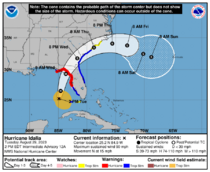Hurricane Idalia facts for kids
|
|||
| Current storm information | |||
|---|---|---|---|
| As of | 11:00 p.m. EDT August 31 (03:00 UTC) September 1 | ||
| Location | 33°06′N 71°30′W / 33.1°N 71.5°W ± 30 nm About 270 mi (435 km) ESE of Cape Hatteras, North Carolina About 395 mi (635 km) W of Bermuda |
||
| Movement | E at 23 mph (37 km/h) | ||
|
Part of the 2023 Atlantic hurricane season |
|||
Hurricane Idalia was a powerful tropical cyclone that caused a lot of damage in parts of the United States in August 2023. It started as a low-pressure area and grew stronger as it moved across the warm waters of the Caribbean Sea and the Gulf of Mexico. Idalia became a Category 4 hurricane before hitting Florida, then moved across Georgia and the Carolinas. After that, it went out into the Atlantic Ocean and changed into a post-tropical cyclone.
Contents
How Idalia Formed
Idalia began as a low-pressure area that crossed from the eastern Pacific Ocean into Central America. This type of weather system often brings rain and thunderstorms. As it moved into the western Caribbean Sea, it started to get more organized.
From Depression to Tropical Storm
On August 26, 2023, the system became strong enough to be called a tropical depression. This is the first stage of a tropical cyclone. Just one day later, on August 27, it strengthened even more and became a tropical storm. At this point, it was given the name Idalia.
Idalia's Journey and Strength
After becoming a tropical storm, Idalia moved into the Gulf of Mexico. The warm waters of the Gulf helped it grow very quickly.
Rapid Intensification
Idalia went through something called rapid intensification. This means a tropical cyclone's wind speed increases very fast in a short amount of time. Idalia quickly became a major hurricane, reaching Category 4 hurricane strength. This happened just before it reached the coast of Florida.
Making Landfall in Florida
On August 30, Idalia made landfall in the Big Bend region of Florida. When it hit land, it was a strong Category 3 hurricane. This area is known for its low-lying coastlines, which made it very vulnerable to the storm's powerful winds and storm surge.
Moving Through the Southeast
After hitting Florida, Idalia continued to move inland. It remained a hurricane as it crossed into Southeast Georgia. As it moved further, it weakened slightly and became a tropical storm when it pushed into the Carolinas. Tropical storms still bring strong winds and heavy rain, which can cause flooding and damage.
Becoming a Post-Tropical Cyclone
On August 31, Idalia moved out of the Carolinas and into the Atlantic Ocean. Over the ocean, it started to change.
What is a Post-Tropical Cyclone?
A post-tropical cyclone is a storm that used to be a tropical cyclone (like a hurricane or tropical storm) but has lost its tropical features. This means it no longer gets its energy from warm ocean waters. Instead, it gets its energy from differences in temperature in the atmosphere, similar to how regular winter storms form. Even though it's "post-tropical," it can still bring strong winds, heavy rain, and dangerous waves. Idalia became a post-tropical cyclone on August 31 as it approached Bermuda.
Where Can You Learn More?

- Weather of 2023
- Tropical cyclones in 2023
- Timeline of the 2023 Atlantic hurricane season



